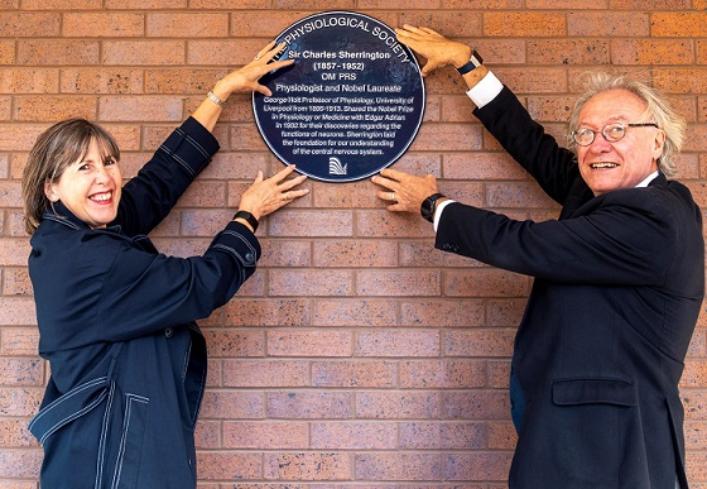Unveiling of commemorative blue plaque to honour Nobel Laureate, Professor Sir Charles Sherrington.
.jpg)
On a windy but bright sunny day on 29 September 2021, the University of Liverpool Vice Chancellor, Professor Dame Janet Beer together with the President of the Physiological Society; Professor David Paterson unveiled a plaque to celebrate the life, work and contribution of Nobel Laureate, Professor Sir Charles Sherrington to the University and to the history of Liverpool.
Professor Sir Charles Sherrington is widely celebrated as the neurophysiologist who shaped modern understanding of the central nervous system in his seminal 1906 publication: “The integrative action of the nervous system”.

Charles Scott Sherrington was born in 1857 in Islington, London and raised by his mother and step-father who was a physician, a classical scholar and an amateur geologist and archaeologist. It is thought that this environment stimulated Sherrington's academic sense of wonder.
Charles began his career at St Thomas Hospital, central London where he began his clinical training. He then went on to study at Caius College, Cambridge.
Sherrington was invited in 1895 to become Holt Professor of Physiology at the University of Liverpool. His time here would prove to be one of the most productive periods in his career. Sherrington’s son wrote that his parents’ time in Liverpool were the happiest years of their lives. In 1913, he left to take up the Waynflete Chair of Physiology at Oxford University where he remained until his retirement in 1936.
To many, Charles Scott Sherrington is best known for providing us with the term ‘synapse’ used to describe the junction where two neurons communicate and also for helping to elucidate the ‘knee jerk response’.
His observations regarding the synapse were only a part of a much greater investigation into reflexes and nerve-muscle communication. His work on the spinal reflexes led Sherrington to the discovery that muscles didn’t just receive innervation from nerves travelling from the spinal cord but also sent sensory information about muscle length, tension and position back to the spinal cord.
Professor Sherrington received the Nobel Prize in 1932 jointly with Lord Edgar Douglas Adrian at Cambridge for their discoveries demonstrating neuronal function and the reciprocal innervation of muscles.
Sherrington also made key contributions during WWI studying industrial fatigue while employed in a shell factory where he worked shifts of over 75 hours a week. He was also a powerful advocate for women in science, fighting for women to be admitted to the medical school in Oxford and to be eligible for membership to the Physiological Society.
In addition to the plaque unveiling and commemorative speeches given by the University's Vice Chancellor and President of the Physiological Society, the event also included a lecture celebrating the life and work of Charles Sherrington by Emeritus Professor of Physiology; Graham Dockray, University of Liverpool and also a seminar exploring mitochondrial physiology by Michael Duchen, Professor of Physiology at University College, London.
This is the third commemorative blue plaque to be erected by the Physiological Society. They are intended to raise the visibility of physiology with the public and demonstrate the legacy of physiology academic to potential students and give the wider public an insight into the positive role that life sciences plays in their everyday lives.
The Physiological Society works with many institutions to erect blue plaques across the UK and Ireland, celebrating and recognising institutions where distinguished physiologists such as Nobel Laureates have made significant contributions to the discipline.
As the largest network of physiologists in Europe, the Physiological Society have a 140 year tradition of being at the forefront of the life sciences bringing together scientists from over 60 countries Nobel Prize-winning members including Ivan Pavlov and John O’Keefe.
Sir Charles Sherrington has had not one, but two blue Physiological Society plaques erected: one located at Department of Physiology Anatomy & Genetics, University of Oxford, UK together with the plaque here at University of Liverpool Sherrington Building, Ashton Street, Liverpool UK.
- Sir Charles Sherrington's The integrative action of the nervous system: a centenary appreciation. Robert E Burke, Brain, Volume 130, Issue 4, April 2007, Pages 887–894, https://doi.org/10.1093/brain/awm022
- Sir Charles Sherrington’s Nobel Lecture: 12 Dec 1932.
- Further experimental note on correlation of antagonistic muscles. CS. Sherrington. Proceedings of the Royal Society of London. 01 Jan 1893. https://doi.org/10.1098/rspl.1893.0032
- Sherrington. His Life and Thought. Eccles JC, Gibson WC. https//www.springer.com/gp/book/9783642618666